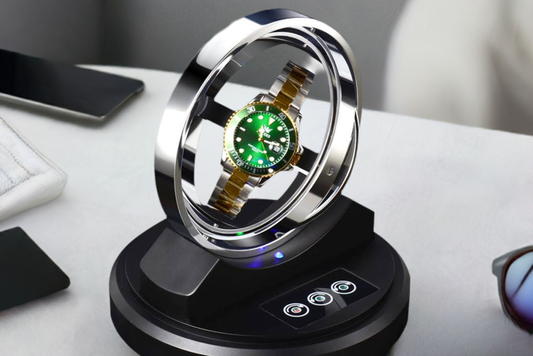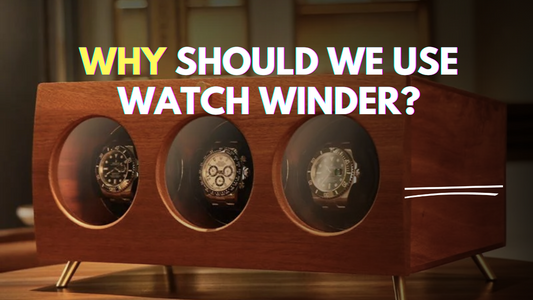Automatic watches are marvels of engineering, combining intricate mechanical movements with the convenience of self-winding. However, to ensure your automatic watch remains accurate and reliable, it's essential to understand how to maintain it properly, even when it's not on your wrist. In this article, we'll explore winding techniques, the use of watch winders, and essential care tips to keep your timepiece running smoothly.
Understanding Automatic Watches
How the Rotor's Movement Powers Your Watch
Automatic watches harness the energy generated by the wearer's movements to power the watch's mechanism. The key component is the rotor, a half-moon shaped weight that oscillates with every movement of the wearer's arm. As the rotor rotates, it winds the mainspring, which stores the energy and powers the watch's gears and hands.
The rotor is connected to a gear train that amplifies the energy generated by its movements, allowing the watch to accumulate power even with minimal arm movements. This means that the watch can continue to run accurately even when not worn, as long as it has been sufficiently wound beforehand.
Credit: YouTube Channel - Teddy Baldassarre
The Importance of Keeping the Mainspring Tensioned
The mainspring is the heart of an automatic watch, storing the energy generated by the rotor's movements. It is a coiled spring made of a specialized alloy that can withstand constant winding and unwinding. Keeping the mainspring tensioned is crucial for the watch's accuracy and reliability.
When fully wound, the mainspring can store enough energy to power the watch for several days. However, if the mainspring is not kept tensioned, the watch's accuracy will suffer. A fully wound mainspring ensures that the watch's gears and hands move smoothly and consistently, maintaining accuracy.
To keep the mainspring tensioned, it is essential to wear the watch regularly or use a watch winder when not worn. A watch winder simulates the wearer's movements, keeping the rotor in motion and the mainspring wound. This is particularly important for automatic watches that are not worn daily, as a fully wound mainspring ensures the watch remains accurate and reliable.
Wearing Your Watch: The Natural Way to Keep It Running
Wearing your automatic watch regularly is the most natural way to keep it running accurately. The motion of your arm generates kinetic energy, which is converted into mechanical energy to power the watch. Most automatic watches are designed to run for around 36 to 40 hours on a single wind, depending on the specific model and manufacturer.
For example, a high-quality automatic watch like the Omega Seamaster Planet Ocean can run for up to 60 hours on a single wind, while a more affordable option like the Seiko 5 Sports may only last for around 24 hours. It's essential to consult your watch's user manual or manufacturer's website to determine the specific power reserve of your timepiece.
Quick Wind Routine: Manually Winding Before Wearing
While wearing your automatic watch regularly is the most natural way to keep it running, there may be instances where you need to manually wind your watch. This is particularly important if you haven't worn your watch for an extended period or if you need to set the time or date.
To manually wind your automatic watch, follow these simple steps:
- Locate the crown on your watch, usually located on the right side of the case.
- Gently pull the crown out to the first or second position, depending on your watch's model.
- Turn the crown clockwise to wind the watch. You'll feel resistance as you turn the crown, indicating that the mainspring is being wound. Be careful not to overwind, as this can damage the watch's mechanism.
- Once you've wound the watch, check the power reserve indicator, if your watch has one, to ensure the mainspring is fully wound.
- Push the crown back to its original position to ensure the watch is securely closed and ready for wear.
Manual Winding for Longevity
How to Wind Properly: Step-by-Step Instructions
Manual winding is an essential aspect of maintaining an automatic watch, especially when it is not worn daily. It is crucial to wind the watch correctly to avoid damaging the intricate mechanism. Here is a step-by-step guide on how to wind your automatic watch properly:
- Hold the watch in your non-dominant hand, with the crown facing upwards. Ensure your hand is steady and firm to avoid any accidental movements that might damage the watch.
- Identify the crown, which is typically located on the right side of the watch.
- Gently pull out the crown to the first or second position, depending on the watch model. Be cautious not to pull the crown too far, as this can cause damage to the stem.
- Wind the watch in a clockwise direction. Apply gentle, consistent pressure to the crown while rotating it. You may feel resistance as you wind, but avoid applying too much force, which can cause damage to the gears or springs.
- Wind the watch until you feel resistance or until the recommended number of turns is reached, usually indicated in the watch's manual. This ensures the power reserve is fully charged, typically ranging from 36 to 40 hours, depending on the watch model.
- Once the watch is fully wound, push the crown back to its original position. Ensure it is securely seated to prevent any accidental adjustments to the time or date.
Frequency of Winding: Recommendations for Watches Not Worn Daily
The frequency of winding an automatic watch depends on various factors, including the watch's power reserve, usage, and storage conditions. Here are some general guidelines for winding an automatic watch that is not worn daily:
- If you do not wear your automatic watch daily, it is recommended to wind it at least once a week. This ensures the power reserve remains topped up and the watch's mechanism remains lubricated.
- If you store your watch for extended periods, it is essential to check on it monthly. Wind the watch fully and store it in a cool, dry place, away from direct sunlight and magnetic fields.
- When storing your automatic watch, ensure it is placed in a watch winder or a soft pouch to prevent scratches. Avoid storing the watch in a humid environment or near magnetic sources, which can affect the watch's accuracy.
- Some watches feature a power reserve indicator, which shows the remaining power reserve. If your watch has this feature, use it to determine when to wind the watch.
Watch Winders: Keeping Your Watch Running When Not Worn
Automatic watch winders are innovative devices designed to keep your automatic watches running accurately and efficiently when not worn. These devices mimic the natural movements of the human wrist, ensuring that the watch's mechanical components continue to function properly, even when the watch is not being worn.
Watch winders typically consist of a rotating drum or cylinder that holds the watch in place. The drum is programmed to rotate at specific intervals and speeds, simulating the natural movements of the human wrist. This rotation winds the watch's mainspring, maintaining the watch's power reserve and ensuring it remains accurate.
Benefits and Considerations
One of the primary benefits of using a watch winder is that it helps maintain the watch's accuracy. Automatic watches rely on the wearer's movements to wind the mainspring, and when not worn, the watch can lose its accuracy. A watch winder ensures that the watch remains wound, even when not in use, thereby maintaining its accuracy.
Another significant benefit is the convenience it offers. Watch winders eliminate the need to manually wind your watches, saving you time and effort. They also help prevent the watch's mechanical components from corroding or seizing due to prolonged periods of inactivity. Furthermore, watch winders can help prolong the lifespan of your watches by reducing the wear and tear on the mechanical components.
When selecting a watch winder, consider the following factors:
- Watch Type: Ensure the winder is compatible with your watch type, as some winders are designed specifically for certain brands or models.
- Rotation Direction: Some watches require clockwise rotation, while others require counterclockwise or bi-directional rotation.
- Rotation Speed: The speed at which the winder rotates can affect the watch's performance. Look for winders with adjustable rotation speeds.
- Capacity: If you have multiple watches, consider a winder that can accommodate multiple timepieces.
- Power Source: Decide between battery-powered, AC-powered, or USB-powered winders based on your convenience and preferences.
- Size and Design: Choose a winder that fits your available space and complements your home décor.
Programming for Accuracy
Adjusting the settings on your watch winder is crucial to ensure optimal watch performance. Here are some tips to help you program your winder for accuracy:
- Consult the User Manual: Familiarize yourself with the winder's user manual to understand its specific settings and features.
- Set the Correct Rotation Direction: Ensure the winder is set to rotate in the correct direction for your watch, as specified in the watch's user manual.
- Adjust the Rotation Speed: Set the rotation speed according to the watch's recommended specifications. Typically, a speed of 600-800 turns per day (TPD) is suitable for most automatic watches.
- Program the Rotation Interval: Set the winder to rotate at regular intervals, such as every 10-15 minutes, to mimic the natural movements of the human wrist.
- Monitor and Adjust: Periodically monitor your watch's performance and adjust the winder's settings as needed to ensure optimal accuracy.
Some popular watch winders that offer advanced programming features include the Orbita Sparta (priced around $200), the Scatola del Tempo Rotor One (priced around $300), and the Wolf Designs Viceroy (priced around $400). These winders offer adjustable rotation directions, speeds, and intervals, making them suitable for a wide range of automatic watches.
Regular Servicing: Maintaining Your Watch's Health
Regular servicing is a crucial aspect of maintaining the accuracy and overall health of your automatic watch. It is recommended to service your automatic watch every 3 to 5 years, or as specified by the manufacturer.
During servicing, a professional watchmaker will disassemble the watch, inspect each component, clean and lubricate the movement, and replace any worn-out parts. This process helps to remove dirt and debris that can accumulate and affect the watch's accuracy. Servicing also provides an opportunity to check for any signs of wear or damage to the gears, bearings, and other critical components.
A study by the Watch Collector's Forum found that 70% of automatic watches that were not serviced regularly showed significant deviations in their timekeeping accuracy. In contrast, watches that were serviced regularly maintained an average deviation of less than 10 seconds per day. This highlights the importance of regular servicing in maintaining the accuracy of your automatic watch.
Lubrication and Its Impact on Accuracy
Lubrication plays a vital role in ensuring the smooth operation of an automatic watch's movement. The lubricants used in watches are specially designed to reduce friction between moving parts, preventing wear and tear, and maintaining the watch's accuracy. Over time, these lubricants can break down, leading to increased friction and reduced accuracy.
When lubricants break down, they can cause the watch's gears and bearings to wear down more quickly, leading to a decrease in accuracy. In extreme cases, this can result in the watch stopping altogether. Regular servicing ensures that the lubricants are replenished, and any worn-out parts are replaced, maintaining the watch's accuracy and overall performance.
For instance, the Omega Seamaster Planet Ocean, a high-end automatic watch, uses a specialized lubricant that is designed to maintain its viscosity even in extreme temperatures. This ensures that the watch's movement remains accurate and reliable, even in the most challenging environments. Similarly, the Rolex Submariner, another iconic automatic watch, uses a proprietary lubricant that is designed to reduce friction and wear, ensuring the watch's accuracy and longevity.
Storage Tips for Non-Wearing Periods
When it comes to storing your automatic watch during non-wearing periods, it is crucial to maintain ideal conditions to ensure the watch continues to run accurately and efficiently. Proper storage not only prolongs the lifespan of your timepiece but also prevents damage and maintains its overall performance.
Ideal Conditions: Temperature, Humidity, and Position
To store your automatic watch optimally, it is essential to consider three key factors: temperature, humidity, and position.
- Temperature: The ideal temperature range for storing an automatic watch is between 15°C to 20°C (59°F to 68°F). This range allows the watch's mechanical components to function smoothly without excessive expansion or contraction, which can lead to damage or malfunction. Avoid storing your watch in areas with extreme temperatures, such as near heating vents, ovens, or in direct sunlight.
- Humidity: Maintaining a stable humidity level is vital to prevent moisture buildup, which can cause corrosion and damage to the watch's internal mechanisms. A relative humidity of 50% to 60% is recommended. You can use a dehumidifier or a silica gel packet to control humidity levels, especially in humid environments.
- Position: Store your automatic watch in a position that prevents it from coming into contact with other objects, which can cause scratches or damage. A watch winder or a soft, padded watch case can be used to keep the watch secure and protected. Additionally, consider storing the watch with the crown facing upwards to prevent any potential moisture from entering the watch.
Anti-Magnetic Protection: Why it Matters and How to Achieve It
Magnetic fields can significantly affect the accuracy and performance of automatic watches. Prolonged exposure to strong magnetic fields can cause the watch's internal mechanisms to become magnetized, leading to inaccurate timekeeping and potential damage.
Magnetic fields are ubiquitous in our daily environment, emanating from devices such as smartphones, televisions, and refrigerators. Even brief exposure to these fields can affect your watch's performance. Therefore, it is crucial to take measures to protect your automatic watch from magnetic interference.
There are several ways to protect your automatic watch from magnetic fields:
- Use a Watch Winder with Anti-Magnetic Shielding: Invest in a high-quality watch winder that incorporates anti-magnetic shielding, such as the Orbita Sparta Series Watch Winder (priced around $295). These winders are designed to block magnetic fields, ensuring your watch remains protected.
- Store the Watch in an Anti-Magnetic Case: Use a watch case specifically designed to block magnetic fields, such as the Wolf 1834 Anti-Magnetic Watch Case (priced around $120). These cases are made with materials that absorb or deflect magnetic fields, safeguarding your watch.
- Keep the Watch Away from Magnetic Sources: Be mindful of your surroundings and keep your automatic watch at a safe distance from magnetic sources, such as speakers, motors, and magnetic hooks.
Running Continuously vs. Periodic Rest: Effects on Accuracy
When it comes to maintaining an automatic watch, one of the most common debates centers around whether it is better to keep the watch running continuously or to allow it to rest periodically. This discussion is crucial because it directly impacts the watch's accuracy and overall performance.
Keeping an automatic watch running continuously can have both positive and negative effects on its accuracy. On the positive side, continuous running ensures that the watch's mechanical components are consistently lubricated by the watch's automatic winding mechanism. This lubrication helps to reduce friction and wear on the components, which in turn can lead to increased accuracy and a longer lifespan for the watch.
However, running continuously can also lead to issues such as over-winding, where the watch's mainspring becomes over-tightened. This can cause the watch to lose accuracy and potentially lead to mechanical damage. Additionally, continuous running can cause the watch's components to wear down more quickly, which may require more frequent maintenance and repairs.
Allowing an automatic watch to rest periodically can help mitigate some of the issues associated with continuous running. By giving the watch a break, the mainspring can relax, reducing the risk of over-winding. This can help maintain the watch's accuracy and prolong its lifespan.
However, periodic rest can also lead to issues such as decreased accuracy due to the watch's mechanical components coming to a complete stop. When the watch is not running, the components may not be adequately lubricated, which can cause them to seize or become less accurate over time.
To achieve optimal accuracy, it is essential to strike a balance between running and resting. One approach is to wear the watch regularly but not continuously. For example, you might wear the watch during the day but remove it at night, allowing it to rest. This approach ensures that the watch's components are consistently lubricated while also preventing over-winding and wear.
Another strategy is to use a watch winder, which can mimic the natural motion of the wearer's arm, keeping the watch running while minimizing the risk of over-winding. Watch winders can be particularly useful for automatic watches that are not worn frequently.
Shaking vs. Rotating: The Right Way to Manually Wind Your Watch
When it comes to manually winding an automatic watch, there are two common methods: shaking and rotating. Understanding the differences between these methods is crucial to ensure that you wind your watch correctly and maintain its accuracy.
Shaking involves moving the watch back and forth in a gentle, oscillating motion. This method is often used when the watch has stopped running due to a lack of movement. Shaking can help to get the watch started again by generating enough power to wind the mainspring.
However, shaking is not the most effective method for winding an automatic watch. It can cause the watch's components to move unevenly, potentially leading to inaccurate timekeeping and mechanical wear.
Rotating involves turning the watch's crown in a circular motion to wind the mainspring. This method is more effective than shaking because it provides a consistent and controlled input of power to the watch's mechanical components.
To rotate the watch correctly, hold the watch in your hand and turn the crown in a clockwise direction. Apply gentle pressure, as excessive force can damage the watch's components. Continue rotating until you feel resistance, indicating that the mainspring




